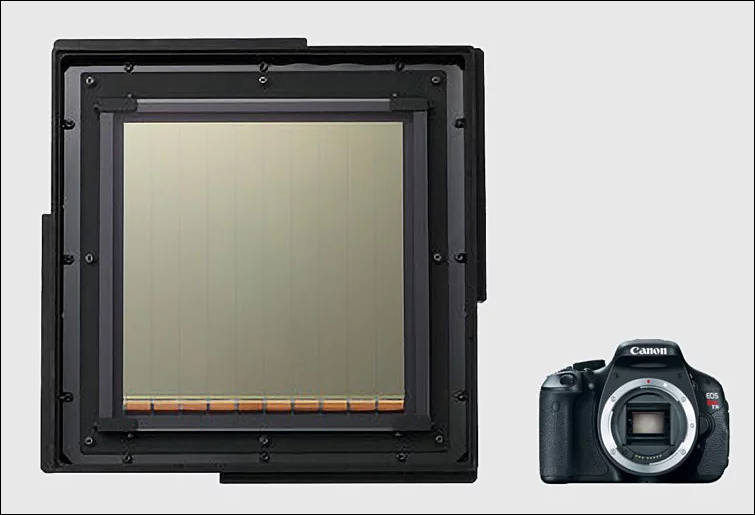
It allows to keep PV going, with more focus towards AI, but keeping be one of the few truly independent places.
-

A certain level of light is required when shooting with a digital camera or camcorder, and without it, images cannot be captured due to insufficient sensitivity.
In the pursuit of further improving the sensitivity of imaging elements, Canon has embraced the challenge of achieving higher levels of sensitivity and larger element sizes while maintaining high-speed readout performance, and has succeeded in developing the world's largest class of CMOS image sensor measuring approximately 20 cm square. At present, the standard diameter of the silicon wafers on which CMOS sensors are fabricated is 12 inches (approx. 30 cm). As such, a 20-cm-square sensor is the largest size that can be manufactured based on these dimensions, and is equivalent to nearly 40 times the size of a 35 mm full-frame CMOS sensor.
Increasing the size of CMOS sensors entails overcoming such problems as distortion and transmission delays for the electrical signals converted from light. To resolve these issues, Canon not only made use of a parallel processing circuit, but also exercised ingenuity with the transfer method itself. As a result, the sensor makes possible the shooting of video at 60 frames per second with only 0.3 lux of illumination (approximately the same level of brightness as that generated by a full moon).
Possible applications for this ultrahigh-sensitivity CMOS sensor include the video recording of celestial objects in the night sky, nocturnal animal behavior and auroras, and use in nightwatch cameras.
When installed in the 105 cm Schmidt camera at the Kiso Observatory operated by the University of Tokyo's Institute of Astronomy, the ultrahigh-sensitivity sensor made possible the world's first video recording of meteors with an equivalent apparent magnitude of 10, a level so dark that image capture had not been possible until now. As a result, the sensor provided proof that the frequency with which faint meteors occurred coincided with theoretical estimates to date. By supporting more detailed recording and statistical analysis of meteors, the technology could lead to an increased understanding of the influence that meteors may have exerted on the development of life on Earth.

 sa3661.jpg755 x 515 - 39K
sa3661.jpg755 x 515 - 39K -
May be reason of so many orders for Tesla Trucks among elites :-) So you'll have your new high end camera near you all the time.
-
It's easy enough to imagine the lens for it. I have a couple of them here already - any lens that covers 8x10 film should have no problem covering an approximately 8x8 sensor. Even my super heavy Aero-Ektar feels like it weighs less than a 70-200/2.8. :)
Howdy, Stranger!
It looks like you're new here. If you want to get involved, click one of these buttons!
Categories
- Topics List23,992
- Blog5,725
- General and News1,354
- Hacks and Patches1,153
- ↳ Top Settings33
- ↳ Beginners256
- ↳ Archives402
- ↳ Hacks News and Development56
- Cameras2,367
- ↳ Panasonic995
- ↳ Canon118
- ↳ Sony156
- ↳ Nikon96
- ↳ Pentax and Samsung70
- ↳ Olympus and Fujifilm101
- ↳ Compacts and Camcorders300
- ↳ Smartphones for video97
- ↳ Pro Video Cameras191
- ↳ BlackMagic and other raw cameras116
- Skill1,960
- ↳ Business and distribution66
- ↳ Preparation, scripts and legal38
- ↳ Art149
- ↳ Import, Convert, Exporting291
- ↳ Editors191
- ↳ Effects and stunts115
- ↳ Color grading197
- ↳ Sound and Music280
- ↳ Lighting96
- ↳ Software and storage tips266
- Gear5,420
- ↳ Filters, Adapters, Matte boxes344
- ↳ Lenses1,582
- ↳ Follow focus and gears93
- ↳ Sound499
- ↳ Lighting gear314
- ↳ Camera movement230
- ↳ Gimbals and copters302
- ↳ Rigs and related stuff273
- ↳ Power solutions83
- ↳ Monitors and viewfinders340
- ↳ Tripods and fluid heads139
- ↳ Storage286
- ↳ Computers and studio gear560
- ↳ VR and 3D248
- Showcase1,859
- Marketplace2,834
- Offtopic1,320





